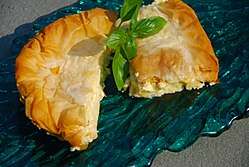Tiropita
Tiropita or tyropita (Greek: τυρóπιτα, "cheese-pie") is a Greek pastry made with layers of buttered phyllo and filled with a cheese-egg mixture.[1] It is served either in an individual-size free-form wrapped shape, or as a larger pie that is portioned.
 Tiropita with garnish. | |
| Place of origin | |
|---|---|
| Main ingredients | phyllo, eggs, cheese |
History
The modern Greek tyropita is historically derived from the tyropatinum, which was a sweet custard developed by the ancient Greeks of Sicily consisting of eggs, ricotta cheese, and honey.[2]
Other scholars suggest that the ancient Greek placenta cake (or plakous, πλακοῦς) and its Eastern Roman (Byzantine) descendant, plakountas tetyromenous (πλακούντας τετυρομένους, "cheesy placenta") and en tyritas plakountas (εν τυρίτας πλακούντας, "cheese-inserted placenta"), are the ancestors of modern tiropita (börek or banitsa).[3][4] Cato the Elder included a recipe for placenta in his De Agri Cultura (160 BC):
Another theory is that layered dishes like tyropita have their origins in Turkish cuisine and may trace back to layered pan-fried breads developed by the Turks of Central Asia before their westward migration to Anatolia in the late Middle Ages (cf. baklava).[6]
References
Citations
- Ozimek, Sarah (1 February 2017). "TIROPITA (GREEK CHEESE PIES)". Curious Cuisinière. Retrieved 10 February 2020.
Tiropita (or tyropita) is a Greek pie made from layers of phyllo dough that are filled with a cheese and egg mixture.
- Musco 2003, "Sicilian Food II; History": "The Greeks in Sicily also made custard of ricotta; honey and eggs called tyropatinum, a sweet version of the modern Greek cheese pie known as tyropita."
- Faas 2005, pp. 184–185.
- Salaman 1986, p. 184; Vryonis 1971, p. 482.
- Cato the Elder. De Agri Cultura, 76.
- Perry 2000, pp. 87–92.
Sources
- Faas, Patrick (2005). Around the Roman Table: Food and Feasting in Ancient Rome. Chicago, IL: University of Chicago Press. ISBN 0226233472.CS1 maint: ref=harv (link)
- Musco, Tom (2003). UMass Journalism Sicily: A History of Sicilian Cuisine. Amherst, MA: University of Massachusetts Journalism Program.CS1 maint: ref=harv (link)
- Perry, Charles (2000). "6. The Taste for Layered Bread among the Nomadic Turks and the Central Asian Origins of Baklava". In Zubaida, Sami; Tapper, Richard; Roden, Claudia (eds.). A Taste of Thyme: Culinary Cultures of the Middle East. London and New York: Tauris Parke Paperbacks. pp. 87–92. ISBN 1860646034.CS1 maint: ref=harv (link)
- Salaman, Rena (1986). "The Case of the Missing Fish, or Dolmathon Prolegomena (1984)". In Davidson, Alan (ed.). Oxford Symposium on Food & Cookery 1984 & 1985, Cookery: Science, Lore and Books Proceedings. London: Prospect Books Limited. pp. 184–187.CS1 maint: ref=harv (link)
- Vryonis, Speros (1971). The Decline of Medieval Hellenism in Asia Minor and the Process of Islamization from the Eleventh through the Fifteenth Century. Berkeley, CA: University of California Press. ISBN 978-0-52-001597-5.CS1 maint: ref=harv (link)